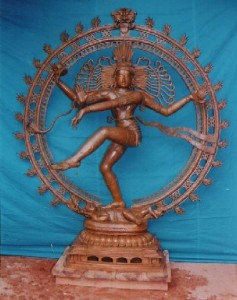Apologies for the really long break I decided to take. Hope to be more regular from now on. Maintaining the balance between Carnatic and Hindustani Ragas, my fourth edition of the “Identity of a Raga” series comes from the North.
One of those Raags to which you can listen no matter what time of the day it is or what mood you are in (atleast for me) happens to be Kedar. I write this post as I listen to a sublime rendition by Kishori Amonkar. I find it difficult to put in words what I’m going through exactly. Her voice seems to transcend all petty feelings and takes you to another spiritual level altogether. I sincerely hope I do some justice to this beautiful Raag.
Let’s start the proceedings with a little theoretical input from my side.
Kedar is part of the Kalyan Thaat, and is mainly sung during the evenings. (Please check my earlier post on Raag classifications in Hindustani music). The Aarohan and Avarohan of Kedar are as follows:
Aarohan: S M, G P, M D, N S
Avarohan: S N D P m P D P M, R S
where ‘M’ represents the Suddha Madhyama and ‘m’ represents the Teevra Madhyama. The vyadi or jeeva swara is the Suddha madhyama.
The Carnatic equivalent of Kedar is Hamir Kalyani which is a janya of the 65th Melakarta Ragam ‘Kalyani’. Although the Aarohan for Hamir Kalyani is the same as that of Kedar’s, the Avarohan differs slightly.
Aarohan: S M, G P, M D, N S
Avarohan: S N D P m G, M R, S
There is a Ragam in Carnatic music called Kedaram which has absolutely nothing to do with Kedar whatsoever. So, kindly don’t mix up the two in your head. The notes for Kedaram are as follows, but forget as you read them!
Aarohan: S M G M P N S
Avarohan: S N P M G R, S
Kedar exemplifies Love. Hence, it is sort of ironic that it should get its name from Lord Shiva, the Lord of Destruction.
The beauty of this raag lies in its simple yet meandering nature of the (swara) usages that mostly revolves around the Suddha madhyama which is the vyaadi or jeeva swara for Kedar. Some of the popular phrases in this Raag include:
G, m, R, S
G, m, D, P
M, G P, m
M, S R S
D P m P
m P D N
N, D, P, m, P
m G, M R
m P D P M, R
m D P M, R
Something that I noticed as I was singing Hamir Kalyani was this: You can use R S N D P in your alaap/vilambit in accordance with the syntax that Kedar requires. However, that phrase is mostly used in Kalyani, so it generally isn’t used while singing Kedar/Hamir Kalyani. Instead, one hears N R S N D P (M D P m R etc from then on, say) or S R S N D P or even M R S N D P (as, in Kalyani, G R S N would be the right way to sing). Please note that although some of the usages follow the correct syntax, they need not necessarily bring out the bhaav of the Raag.
Also, while ascending, P D N S is not allowed, although M P D N S is! This is a very common mistake committed by amateur performers who are just learning the nuances of this Raag. While descending, the phrase P m G R S isn’t allowed. The correct prayoga is always P m R S.
Here are some of the Hindustani compositions in this raag:
1. Nanda Nanda – A popular bandish in Kedar
2. Jaane De Mohe by Pandit Jasraj. If you listen to the pattern of swaras that Jasraj ji sings in this piece, you will see that my description of the Raag fits quite well 🙂
3. This audio is what made it easier for me to decide what Raag to write on!
Here are some of the more popular Carnatic compositions:
1. Purahara Nandana by Dikshitar
2. Parimala Ranganatham by Dikshitar
3. One of the stanzas (paasuram) in Thiruppavai composed by Andal, ‘Thoomani Maadathu’
4. Maanamuleda by Tyagaraja
A huge number of Bollywood songs from the 60s and 70s were composed in this Raag.So, here’s a list of some of the songs that tingle your senses no matter how many times you listen to them:
1. This first song was the regular prayer song for Tuesday mornings at our school (a decade back, nearly!).
Hum Ko Man Ki by Vani Jayaram from the movie Guddi. Wonderful song to listen to that takes you back to those wonderful years.
2. Kisi Ki Yaad by Rafi from the movie Jahanara
3. Mil ja re by Lata ji. from the movie Benazir
4. Another good example of Kedar being used to its full extent. Bekas Pe Karam Kijiye from the movie Mughal-e-Azam sung by Lata ji
A couple from the Carnatic equivalent just to give a perspective:
1. From the classic Raja score for Mani Ratnam’s Nayagan.
2. From Rahman, for Mani’s wife Suhasini Mani Ratnam. Sung by the inimitable Hariharan
3. One from Malayalam
And finally one Kedaar piece from across the border, a song by the band Noori for the Pakistani music show Coke Studio.
So, that, I think, concludes this post on Kedar. I hope you had as much fun reading it as I did coming up with this piece. Most of the times, I must admit, I lost myself in the Raag completely. So, if you find any part of it being discontinuous, it isn’t my fault! 🙂
If you have any queries/suggestions/brickbats, feel free to mail me: ajay.p.raman@gmail.com
Thank you for your time and patience!




